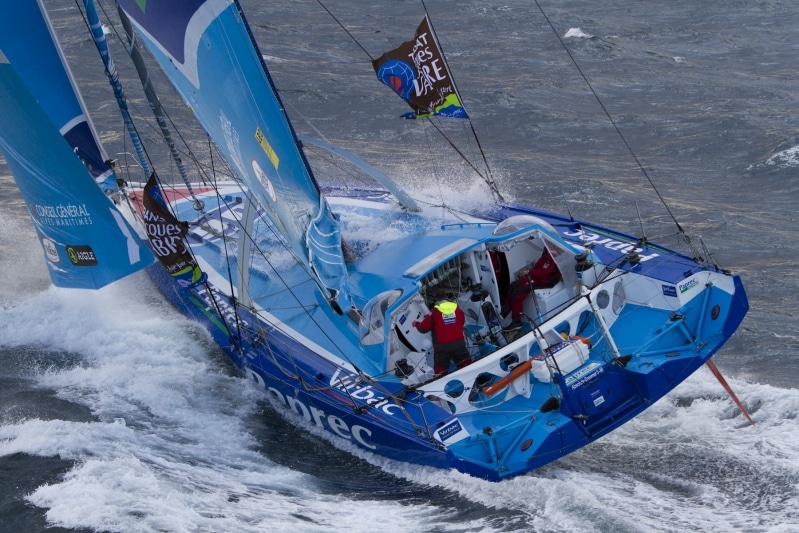
120411_Virbac_Vendee
IMOCA organizers say that the six newest boats signed up for the Vendée Globe are the fastest and safest in the history of the fabled solo, non-stop, around-the-world race. But with seven months until the start, there is significant disagreement on what advantages, if any, the new boats will have over boats built for previous editions of the race.
The six mostly recently designed Vendée Globe boats include PRB, Virbac-Paprec, Banque Populaire, Macif, Acciona, and Cheminées Poujoulat. They were all built to meet new safety-oriented design rules, while older boats registered for the race benefit from a grandfather clause and, thus, only have to meet the requirements for the 2008-’09 Vendée Globe. The new regulations impose a 29-meter mast-height limit, an angle of vanishing stability of at least 110 degrees, and a maximum righting moment of 32 tonne-meters.
Among those critical of IMOCA’s claims that the new boats are safer and faster is Merfyn Owen, of Owen Clarke Design, which designed Acciona. Owen discounted the safety rules as symbolic gestures and nothing more. “There is a political thing going on here,” he said.
“[Changing the AVS rule from 108 degrees to 110 degrees] increased the safety of the boat by nothing, because 2 degrees is nothing,” Owen said. “But what that means is that we needed to win back 160 kg to 180 kg (350 to 400 lbs.) out of the weight of the boat and had to spend a bunch of money to do that.”
Forcing designers to make arbitrary structural changes to the boats can even increase the risk of breakages, Owen said. “When you try to save weight, you are looking at the structures, so you can have problems with hull panels and things like that,” Owen said. “You will thus inevitably take some level of risk, not with the primary structure, but perhaps with the secondary structure.”
The IMOCA organizers, however, see the new IMOCA boats as safer and faster. “The new boats have a speed advantage,” Luc Talbourdet, president of IMOCA, said. Talbourdet estimated that the six most recently built boats will benefit from up to an average of 0.5 knots of extra speed compared to the older boats during the race, despite the design restrictions that the new safety rules have imposed.
The new boats benefit from wider hulls and larger sails, which make them faster in lighter winds, Talbourdet said. Their designers were able to push the size/weight ratio envelope by adding a greater number of lightweight beams built into the structure. “The new boats will likely be on the podium,” Talbourdet said.
However, Owen said it was impossible to gauge the average speeds for the six new IMOCA boats and to test IMOCA’s speed claims at this time. Some of the older boats could benefit from new technologies as well, which could offset any potential speed difference.
Owen also said that marginal speed differences will hardly make a difference anyway. For example, Owen noted that the average boat speed during the Vendée Globe is 13 knots, so a one percent difference totaling 0.13 knots would not make any difference on a daily basis because there “are lots of other things going on.”
As it always has, winning the Vendée also hinges on route choice, seamanship skills, extreme mental and physical toughness, and good luck in avoiding breakages and collisions. Just completing the Mount Everest of ocean racing is a major feat in itself as well. “The great challenge, of course, is to finish the race,” Talbourdet said. “The newest boats have to finish, too.”
Much of the race’s outcome will be determined by what happens in the Atlantic among the leading boats. “In the beginning of the race in the Atlantic,” said Owen, “if you are not quick enough to get into the lead group or if you break something or you make a mistake and you can’t catch up and a lead group picks up on a low on a westerly weather system, then you have lost 800 miles before you know it,” Owen said. “And when you are trying to catch up, you are more likely to break, which is the classic scenario. So you need to be quick down the Atlantic.”
Once in the south, the key is to also remain within the pack, Owen said. “The speed of the boats in the [southern hemisphere] is driven by the ability to control the boat and ease of handling, while experience is very important. You then have five weeks before you come up the Atlantic,” Owen said. “And that is how you design the boats, since that is what the race is about. Speed is a relative thing.”









